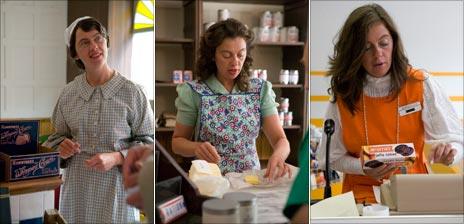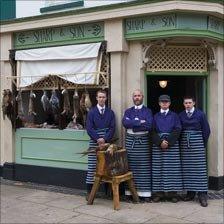When was the High Street at its best?
- Published

Shopkeeper Debbie Sergison spools through different eras
At its birth in the Victorian age, or the gracious Edwardian era? Or more recently, before the arrival of superstores and online rivals? Over the course of six weeks, one market town turned back the clock to try out shopping in each era for itself for BBC One's Turn Back Time.
Today's High Street is not in the rudest health. It must compete with online retailers and super-malls, or risk the whited-out windows and boarded-up shopfronts of empty units.
Nationally, 13% of shops are vacant, up from 12% in 2009. While a feared double-dip recession has yet to materialise, official retail figures, external show weaker than expected sales in September - and that was before the spending cuts and January's looming VAT rise.
It normally takes decades for a shop to spool from bakery to tea shop to milk bar to chain cafe, or ironmonger to penny bazaar to record shop to mobile phone outlet to vacant store.
Most High Streets (it's the most common street name in the UK) show glimpses of their retail history. Look up for bygone trade names in brick or stonework; look down and there may be brand names in doorway mosaics, a form of advertising popular until the 1950s.
To gauge how High Street shopping has changed, empty premises in the once-thriving market square of Somerset's Shepton Mallet turned into time capsules over the summer.
Modern-day shopkeepers lived and worked as Victorians for a week - with the wares, equipment and etiquette of the 1870s - then spent a week as Edwardian retailers, and so on up to the 1970s. Locals were encouraged to shop at these stores.
So when was a golden era for the High Street?
"It was in the 1860s and 70s that the High Street as we know it came about," says social historian Juliet Gardiner.
"Because of urbanisation, people no longer had the facilities to grow food themselves or keep livestock. It was then that market stalls became shops, with fixed prices, customer service and home deliveries to entice people in."
But it wasn't until Edwardian times that shopping came of age, when product choice matched customer service thanks to the riches of the Empire. And its popularity was boosted by the Votes for Women movement.
"The suffragettes were quite bullish about women having somewhere respectable to go on their own - and this meant tea shops and department stores."
The next golden age took 50 years to arrive, she says, when Britain became affluent again in the 1960s.
"Mass production and disposable culture really took off, bringing prices down. Young people didn't want clothes made to last, they wanted fashionable clothes. And in 1964, the Resale Prices Act opened the way for buying in volume and slashing prices."

Andrew Sharp, second left, outside his Edwardian era butchery
What customers gained in choice and discounts, they lost in personal service. "This was the era of self-service and of sniffy boutique girls," says Ms Gardiner.
What about on the other side of the counter? Among the shopkeepers taking part was Andrew Sharp, a butcher with 30 years experience whose family has been in the meat trade for centuries. Which era did he prefer?
"The Edwardian age, without a shadow of a doubt. The level of customer service, the level of formality of the person serving, and the customer too," says Mr Sharp.
This was a time when customers were referred to as sir, madam, miss or master. Staff had to be well turned out at all times. Convivial chats across the counter were frowned upon.
The decor and layout popular at the time is still seen today, particularly among high-end retailers and artisan producers - all muted colours and airy spaces. Selfridges, the London department store, dates from this era - its doors opened in 1909.
The customers lapped it up. "I felt like a lady. I was asked to sit down, and what would you like madam. I wish every shop was like that," said one Shepton Mallet resident after an Edwardian shopping trip.
And, when living the life of a Victorian pork butcher, Mr Sharp rediscovered the art of retail showmanship. His shop looked scarily visceral to 21st Century eyes, its frontage adorned with pigs' heads - complete with glued-on dolls eyes.
To tempt people closer, Mr Sharp did what his Victorian forebears did - live butchery and sausage-making on the street, complete with quick-fire sales patter. It proved a palpable hit.
But what was good for the retailer wasn't so good for the customer - trading standards had yet to be introduced, and until the 1870s there were no laws guaranteeing the quality of goods.
Butchers disguised rancid meat by painting it with chemicals. Bakers bulked up expensive flour with sawdust or plaster of Paris. Grocers added gravel to coffee beans and freshened old vinegar with sulphuric acid. They watered down milk, and added poisonous nasties such as red lead and mercury to cheese, pickles, sweets and tea leaves to improve the colour.
These sharp practices came as a shock to Shepton Mallet's time travelling grocer, Debbie Sergison. She refused to indulge in such dubious methods, but has taken some Victorian methods back to her Lincolnshire deli.
"It was a very manual era, you had to do everything from scratch - we blended tea, roasted coffee and made soap. I'd never thought to blend my own tea before, but it's delicious."
She found life as a 1930s grocer involved stock heavily weighted towards branded goods and confectionery as disposable incomes rose after the Depression, and the 1940s dominated by rationing and absent men. In the 60s came self-service, her shop decked out with new-fangled conveyor belts and pricing so competitive the butcher went out of business. By the 70s, it was a supermarket.
Which, for her, was the golden age? "For the look of the shops, it's the Edwardian era. Everything was so smart. And we had assistants so we could provide great service to our customers."
And did the residents of Shepton Mallet fall back in love with their market square? Yes, to a point.
Some of the time capsule shops once again stand vacant. But hopes are high the 1960s milk bar will reopen, and 1970s boutique will be reborn as a vintage shop.
- Published9 September 2010